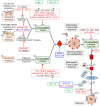Virus-Encoded Complement Regulators: Current Status
- PMID: 33573085
- PMCID: PMC7912105
- DOI: 10.3390/v13020208
Virus-Encoded Complement Regulators: Current Status
Abstract
Viruses require a host for replication and survival and hence are subjected to host immunological pressures. The complement system, a crucial first response of the host immune system, is effective in targeting viruses and virus-infected cells, and boosting the antiviral innate and acquired immune responses. Thus, the system imposes a strong selection pressure on viruses. Consequently, viruses have evolved multiple countermeasures against host complement. A major mechanism employed by viruses to subvert the complement system is encoding proteins that target complement. Since viruses have limited genome size, most of these proteins are multifunctional in nature. In this review, we provide up to date information on the structure and complement regulatory functions of various viral proteins.
Keywords: CD59; Herpesvirus; Poxvirus; RCA; complement; innate immunity; pathogenesis; viral RCA; viral immune evasion.
Conflict of interest statement
The authors declare no conflict of interest. The funders had no role in the design of the study; in the collection, analyses, or interpretation of data; in the writing of the manuscript, or in the decision to publish the results.
Figures


Similar articles
-
The imitation game: a viral strategy to subvert the complement system.FEBS Lett. 2020 Aug;594(16):2518-2542. doi: 10.1002/1873-3468.13856. Epub 2020 Jun 23. FEBS Lett. 2020. PMID: 32506518 Review.
-
Viral complement regulators: the expert mimicking swindlers.Indian J Biochem Biophys. 2007 Oct;44(5):331-43. Indian J Biochem Biophys. 2007. PMID: 18341208 Review.
-
Viral regulators of complement activation: structure, function and evolution.Mol Immunol. 2014 Oct;61(2):89-99. doi: 10.1016/j.molimm.2014.06.004. Epub 2014 Jun 27. Mol Immunol. 2014. PMID: 24976595 Review.
-
Complement and immunity to viruses.Immunol Rev. 1997 Oct;159:69-77. doi: 10.1111/j.1600-065x.1997.tb01007.x. Immunol Rev. 1997. PMID: 9416503 Review.
-
Complement Proteins as Soluble Pattern Recognition Receptors for Pathogenic Viruses.Viruses. 2021 May 2;13(5):824. doi: 10.3390/v13050824. Viruses. 2021. PMID: 34063241 Free PMC article. Review.
Cited by
-
Application of chlorine dioxide and its disinfection mechanism.Arch Microbiol. 2024 Sep 10;206(10):400. doi: 10.1007/s00203-024-04137-7. Arch Microbiol. 2024. PMID: 39256286 Review.
-
A guide to complement biology, pathology and therapeutic opportunity.Nat Rev Immunol. 2024 Feb;24(2):118-141. doi: 10.1038/s41577-023-00926-1. Epub 2023 Sep 5. Nat Rev Immunol. 2024. PMID: 37670180 Review.
-
COVID-19, Pre-Eclampsia, and Complement System.Front Immunol. 2021 Nov 17;12:775168. doi: 10.3389/fimmu.2021.775168. eCollection 2021. Front Immunol. 2021. PMID: 34868042 Free PMC article. Review.
-
Proteins in pregnant swine serum promote the African swine fever virus replication: an iTRAQ-based quantitative proteomic analysis.Virol J. 2023 Mar 28;20(1):54. doi: 10.1186/s12985-023-02004-3. Virol J. 2023. PMID: 36978180 Free PMC article.
-
The Interactions of the Complement System with Human Cytomegalovirus.Viruses. 2024 Jul 20;16(7):1171. doi: 10.3390/v16071171. Viruses. 2024. PMID: 39066333 Free PMC article. Review.
References
-
- Bordet J., Gengou O. Sur l’Existences de Substances Sensibilisatrices dans la Plupart des Serums Anti-Microbiens. Ann. I'Institut Pasteur. 1901;15:289–302.
-
- Ember J.A., Jagels M.A., Hugli T.E. Characterization of Complement Anaphylatoxins and Their Biological Responses. In: Volanakis J.E., Frank M.M., editors. The Human Complement System in Health and Disease. Marcel Dekker, Inc.; New York, NY, USA: 1998. Chapter 11.
Publication types
MeSH terms
Substances
LinkOut - more resources
Full Text Sources
Other Literature Sources
Miscellaneous

